2004 PONTIAC GRAND PRIX roof
[x] Cancel search: roofPage 1 of 432

Seats and Restraint Systems........................... 1-1
Front Seats
............................................... 1-2
Rear Seats
............................................... 1-8
Safety Belts
.............................................1-10
Child Restraints
.......................................1-29
Air Bag Systems
......................................1-48
Restraint System Check
............................1-56
Features and Controls..................................... 2-1
Keys
........................................................ 2-2
Doors and Locks
....................................... 2-7
Windows
.................................................2-12
Theft-Deterrent Systems
............................2-14
Starting and Operating Your Vehicle
...........2-18
Mirrors
....................................................2-33
OnStar
žSystem
......................................2-35
Storage Areas
.........................................2-36
Sunroof
..................................................2-39
Instrument Panel............................................. 3-1
Instrument Panel Overview
.......................... 3-2
Climate Controls
......................................3-25
Warning Lights, Gages and Indicators
.........3-31
Driver Information Center (DIC)
..................3-45
Audio System(s)
.......................................3-88Driving Your Vehicle....................................... 4-1
Your Driving, the Road, and Your Vehicle
..... 4-2
Towing
...................................................4-33
Service and Appearance Care.......................... 5-1
Service
..................................................... 5-3
Fuel
......................................................... 5-4
Checking Things Under the Hood
...............5-10
Headlamp Aiming
.....................................5-56
Bulb Replacement
....................................5-59
Windshield Wiper Blade Replacement
.........5-67
Tires
......................................................5-68
Appearance Care
.....................................5-90
Vehicle Identi®cation
.................................5-98
Electrical System
......................................5-99
Capacities and Speci®cations
...................5-104
Normal Maintenance Replacement Parts
......5-105
Maintenance Schedule..................................... 6-1
Maintenance Schedule
................................ 6-2
Customer Assistance Information.................... 7-1
Customer Assistance Information
.................. 7-2
Reporting Safety Defects
............................ 7-9
Index................................................................ 1
2004 Pontiac Grand Prix Owner ManualM
Page 54 of 432
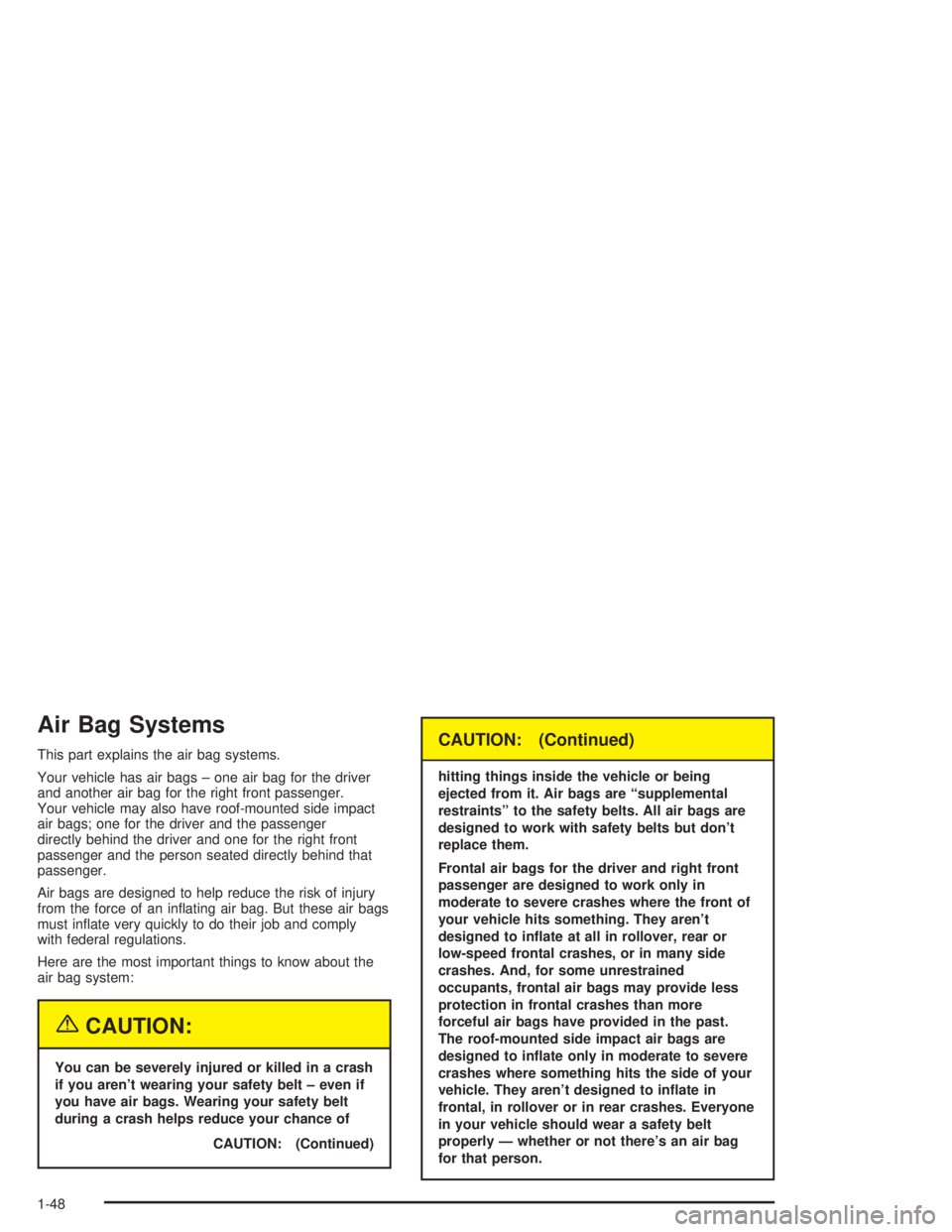
Air Bag Systems
This part explains the air bag systems.
Your vehicle has air bags ± one air bag for the driver
and another air bag for the right front passenger.
Your vehicle may also have roof-mounted side impact
air bags; one for the driver and the passenger
directly behind the driver and one for the right front
passenger and the person seated directly behind that
passenger.
Air bags are designed to help reduce the risk of injury
from the force of an in¯ating air bag. But these air bags
must in¯ate very quickly to do their job and comply
with federal regulations.
Here are the most important things to know about the
air bag system:
{CAUTION:
You can be severely injured or killed in a crash
if you aren't wearing your safety belt ± even if
you have air bags. Wearing your safety belt
during a crash helps reduce your chance of
CAUTION: (Continued)
CAUTION: (Continued)
hitting things inside the vehicle or being
ejected from it. Air bags are ªsupplemental
restraintsº to the safety belts. All air bags are
designed to work with safety belts but don't
replace them.
Frontal air bags for the driver and right front
passenger are designed to work only in
moderate to severe crashes where the front of
your vehicle hits something. They aren't
designed to in¯ate at all in rollover, rear or
low-speed frontal crashes, or in many side
crashes. And, for some unrestrained
occupants, frontal air bags may provide less
protection in frontal crashes than more
forceful air bags have provided in the past.
The roof-mounted side impact air bags are
designed to in¯ate only in moderate to severe
crashes where something hits the side of your
vehicle. They aren't designed to in¯ate in
frontal, in rollover or in rear crashes. Everyone
in your vehicle should wear a safety belt
properly Ð whether or not there's an air bag
for that person.
1-48
Page 58 of 432
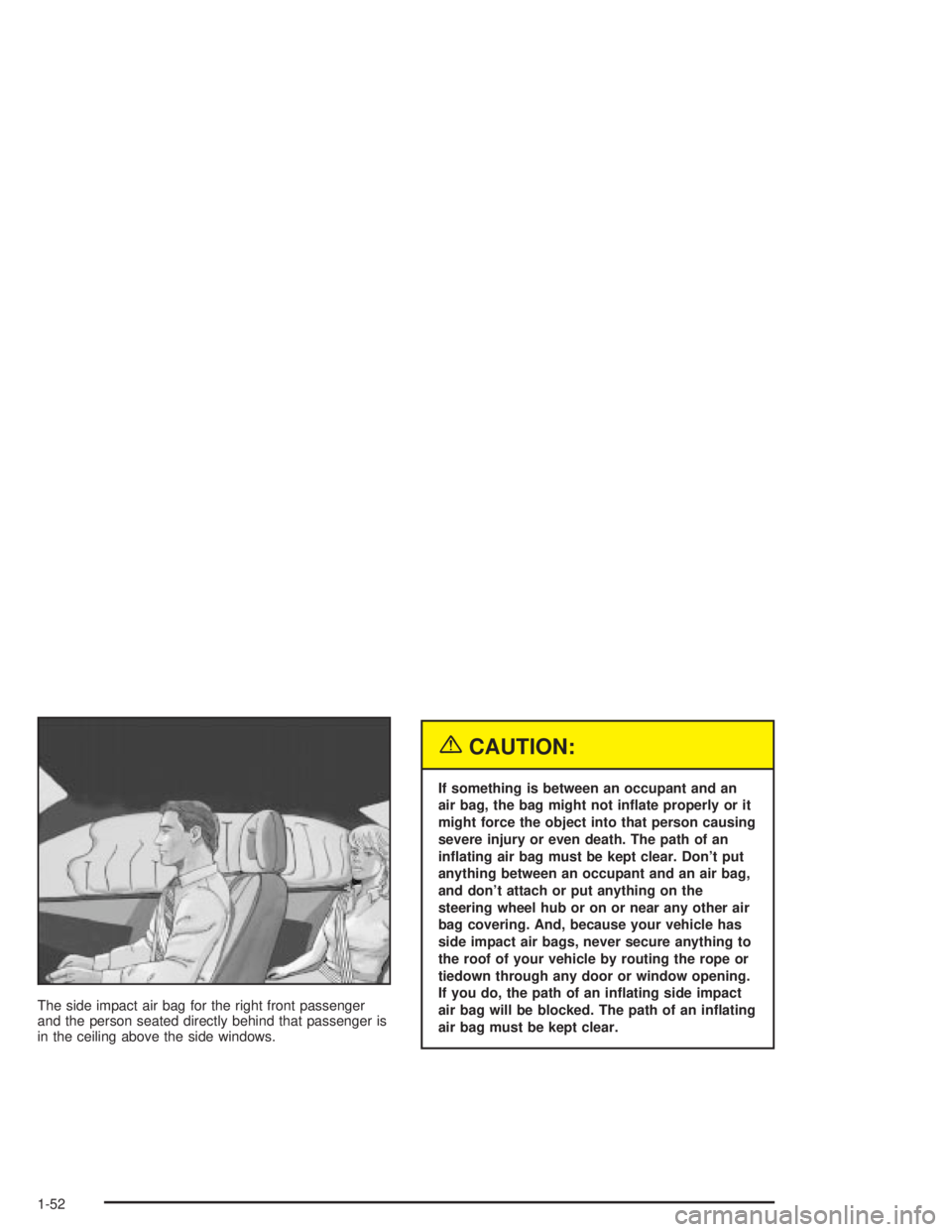
The side impact air bag for the right front passenger
and the person seated directly behind that passenger is
in the ceiling above the side windows.
{CAUTION:
If something is between an occupant and an
air bag, the bag might not in¯ate properly or it
might force the object into that person causing
severe injury or even death. The path of an
in¯ating air bag must be kept clear. Don't put
anything between an occupant and an air bag,
and don't attach or put anything on the
steering wheel hub or on or near any other air
bag covering. And, because your vehicle has
side impact air bags, never secure anything to
the roof of your vehicle by routing the rope or
tiedown through any door or window opening.
If you do, the path of an in¯ating side impact
air bag will be blocked. The path of an in¯ating
air bag must be kept clear.
1-52
Page 61 of 432
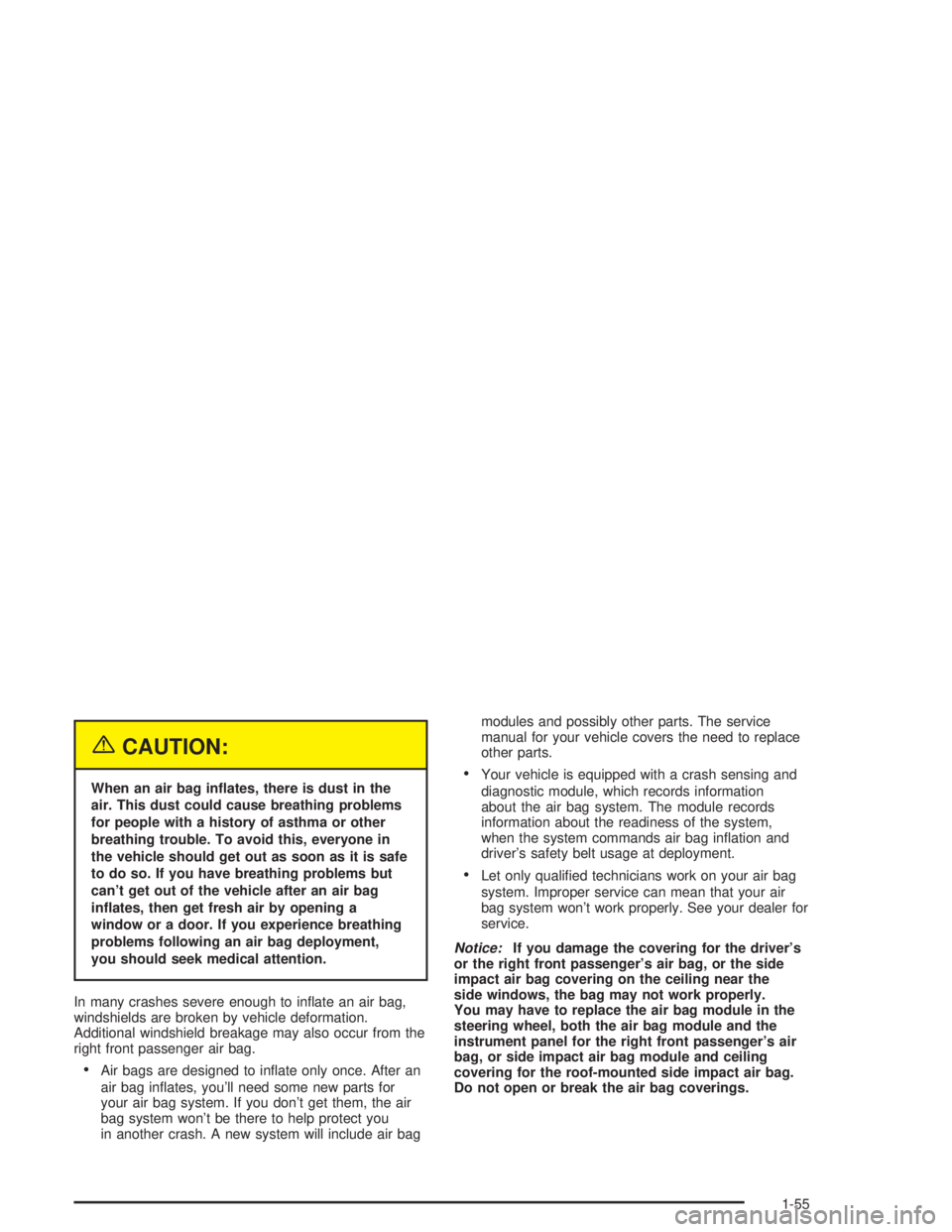
{CAUTION:
When an air bag in¯ates, there is dust in the
air. This dust could cause breathing problems
for people with a history of asthma or other
breathing trouble. To avoid this, everyone in
the vehicle should get out as soon as it is safe
to do so. If you have breathing problems but
can't get out of the vehicle after an air bag
in¯ates, then get fresh air by opening a
window or a door. If you experience breathing
problems following an air bag deployment,
you should seek medical attention.
In many crashes severe enough to in¯ate an air bag,
windshields are broken by vehicle deformation.
Additional windshield breakage may also occur from the
right front passenger air bag.
·Air bags are designed to in¯ate only once. After an
air bag in¯ates, you'll need some new parts for
your air bag system. If you don't get them, the air
bag system won't be there to help protect you
in another crash. A new system will include air bagmodules and possibly other parts. The service
manual for your vehicle covers the need to replace
other parts.
·Your vehicle is equipped with a crash sensing and
diagnostic module, which records information
about the air bag system. The module records
information about the readiness of the system,
when the system commands air bag in¯ation and
driver's safety belt usage at deployment.
·Let only quali®ed technicians work on your air bag
system. Improper service can mean that your air
bag system won't work properly. See your dealer for
service.
Notice:If you damage the covering for the driver's
or the right front passenger's air bag, or the side
impact air bag covering on the ceiling near the
side windows, the bag may not work properly.
You may have to replace the air bag module in the
steering wheel, both the air bag module and the
instrument panel for the right front passenger's air
bag, or side impact air bag module and ceiling
covering for the roof-mounted side impact air bag.
Do not open or break the air bag coverings.
1-55
Page 65 of 432

Keys...............................................................2-2
Remote Keyless Entry System.........................2-4
Remote Keyless Entry System Operation...........2-5
Doors and Locks.............................................2-7
Door Locks....................................................2-7
Power Door Locks..........................................2-8
Last Door Closed Locking................................2-8
Programmable Automatic
Door Locks.................................................2-9
Lockout Protection..........................................2-9
Leaving Your Vehicle......................................2-9
Trunk..........................................................2-10
Windows........................................................2-12
Power Windows............................................2-13
Sun Visors...................................................2-13
Theft-Deterrent Systems..................................2-14
Content Theft-Deterrent.................................2-14
PASS-Key
žIII ..............................................2-15
PASS-KeyžIII Operation...............................2-16
Starting and Operating Your Vehicle................2-18
New Vehicle Break-In....................................2-18
Ignition Positions..........................................2-18
Starting Your Engine.....................................2-19Engine Coolant Heater..................................2-20
Automatic Transaxle Operation.......................2-22
Parking Brake..............................................2-27
Shifting Into Park (P).....................................2-28
Shifting Out of Park (P).................................2-30
Parking Over Things That Burn.......................2-30
Engine Exhaust............................................2-31
Running Your Engine While
You Are Parked........................................2-32
Mirrors...........................................................2-33
Manual Rearview Mirror.................................2-33
Manual Rearview Mirror with OnStar
ž..............2-33
Outside Power Mirrors...................................2-34
Outside Convex Mirror...................................2-34
OnStar
žSystem.............................................2-35
Storage Areas................................................2-36
Glove Box...................................................2-36
Overhead Console........................................2-36
Front Seat Storage Net.................................2-37
Center Console Storage Area.........................2-37
Assist Handles.............................................2-38
Convenience Net..........................................2-38
Sunroof.........................................................2-39
Section 2 Features and Controls
2-1
Page 83 of 432

Notice:If your key seems stuck in OFF and you
can't turn it, be sure you are using the correct key;
if so, is it all the way in? If it is, then turn the
steering wheel left and right while you turn the key
hard. Turn the key only with your hand. Using a
tool to force it could break the key or the ignition
switch. If none of these works, then your vehicle
needs service.
ACC (ACCESSORY):This position lets you use things
like the radio and windshield wipers while the engine
is off.
R(RUN):This position is where the key returns to
after you start the vehicle. With the engine off, you can
use RUN to display some of the warning and indicator
lights.
/(START):This position starts the engine. Let go of
the key when the engine starts. The key will return
to the RUN position.
A continuous warning chime will sound and a KEY IN
IGNITION warning message will display on the DIC
if the key is in the ignition in the OFF or ACCESSORY
positions and the driver's door is opened.
Retained Accessory Power (RAP)
With Retained Accessory Power (RAP), the power
windows, audio system and sunroof will continue to
work up to 10 minutes after the ignition key is turned
to OFF and none of the doors are opened.
Starting Your Engine
1. Move your shift lever to PARK (P) or NEUTRAL (N).
Your engine won't start in any other position ± that's
a safety feature. To restart while you're already
moving, use NEUTRAL (N) only.
Notice:Don't try to shift to PARK (P) if your vehicle
is moving. If you do, you could damage the transaxle.
Shift to PARK (P) only when your vehicle is stopped.
2. With your foot off the accelerator pedal, turn your
ignition key to START. When the engine starts,
let go of the key. The idle speed will go down as
your engine gets warm.
Notice:Holding your key in START for longer than
15 seconds at a time will cause your battery to
be drained much sooner. And the excessive
heat can damage your starter motor. Wait about
15 seconds between each try to help avoid draining
your battery or damaging your starter.
2-19
Page 101 of 432
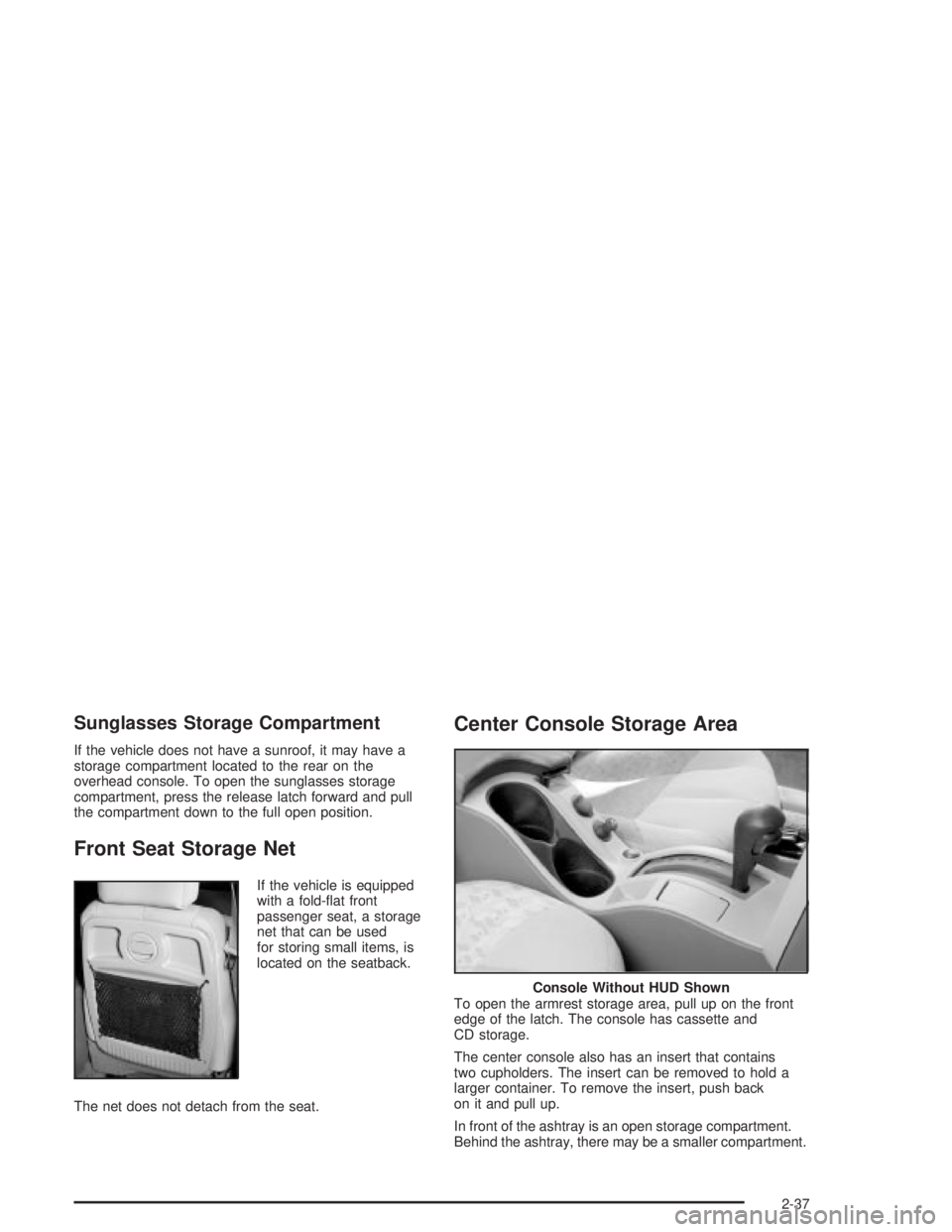
Sunglasses Storage Compartment
If the vehicle does not have a sunroof, it may have a
storage compartment located to the rear on the
overhead console. To open the sunglasses storage
compartment, press the release latch forward and pull
the compartment down to the full open position.
Front Seat Storage Net
If the vehicle is equipped
with a fold-¯at front
passenger seat, a storage
net that can be used
for storing small items, is
located on the seatback.
The net does not detach from the seat.
Center Console Storage Area
To open the armrest storage area, pull up on the front
edge of the latch. The console has cassette and
CD storage.
The center console also has an insert that contains
two cupholders. The insert can be removed to hold a
larger container. To remove the insert, push back
on it and pull up.
In front of the ashtray is an open storage compartment.
Behind the ashtray, there may be a smaller compartment.
Console Without HUD Shown
2-37
Page 103 of 432
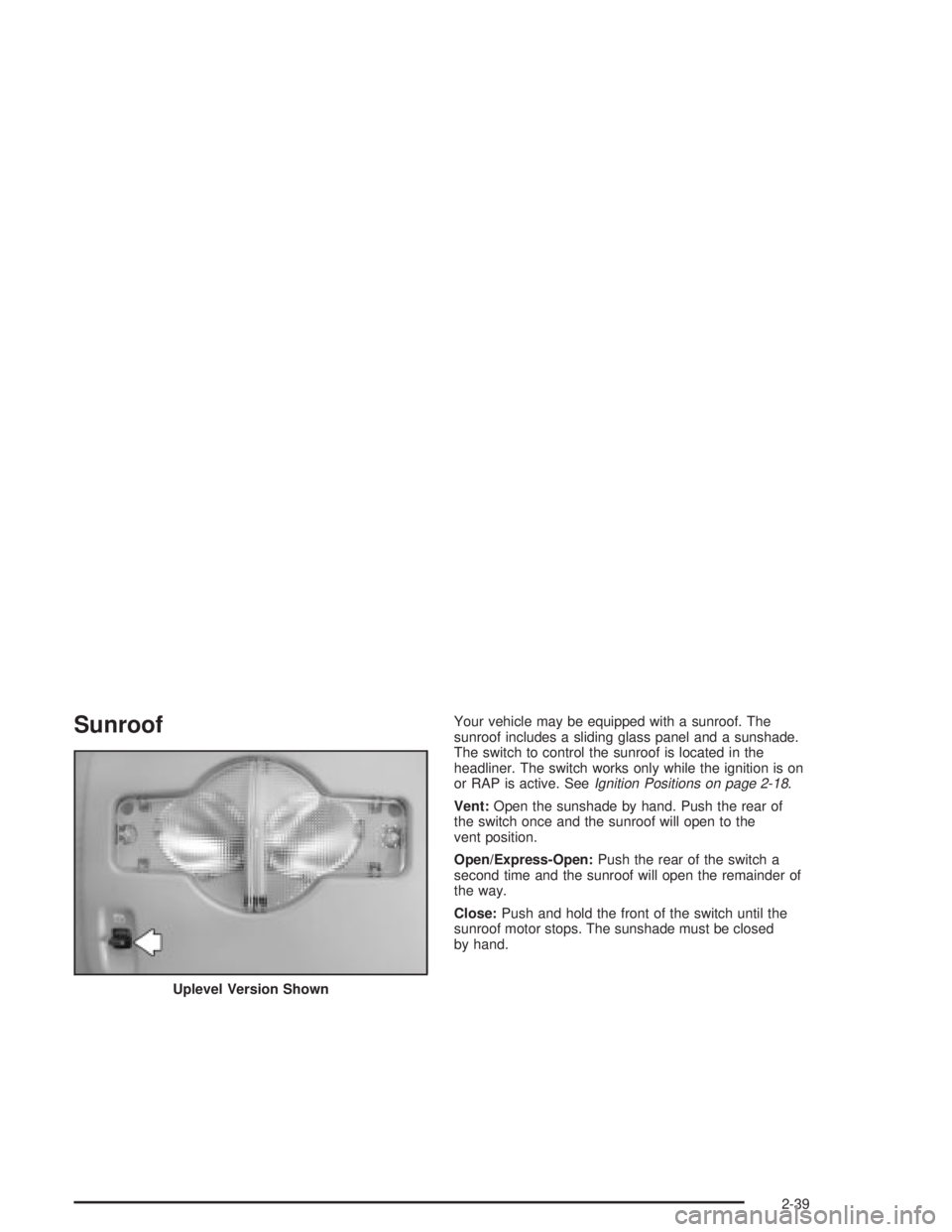
SunroofYour vehicle may be equipped with a sunroof. The
sunroof includes a sliding glass panel and a sunshade.
The switch to control the sunroof is located in the
headliner. The switch works only while the ignition is on
or RAP is active. See
Ignition Positions on page 2-18.
Vent:Open the sunshade by hand. Push the rear of
the switch once and the sunroof will open to the
vent position.
Open/Express-Open:Push the rear of the switch a
second time and the sunroof will open the remainder of
the way.
Close:Push and hold the front of the switch until the
sunroof motor stops. The sunshade must be closed
by hand.
Uplevel Version Shown
2-39